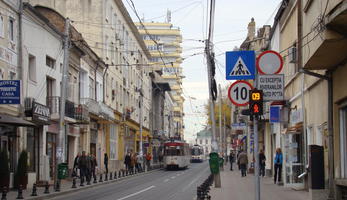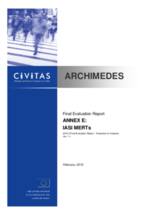Access control to a historic centre
Summary
Iasi wishes to promote the use of soft transport modes - cycling and walking - within its city centre. Apart from the environmental benefits, it is expected that a quieter city centre will encourage the development of tourism.
Implementing sustainable mobility
The historical centre in Iasi is currently open to all traffic, there is an urgent need to reduce traffic to increase the attractiveness and make the area more people friendly. The demonstration will implement an access control scheme. The measure aims for:
- A radical reduction in the use of private cars in the historical area of the city
- Limited negative impacts on congestion levels on neighbouring roads
- Reduced emissions of noise and air pollutants
- More use of public transport, walking and cycling, through a more equitable sharing of space.
Progress
Iasi implemented an access control scheme that restricts the access to the historic city centre by April 2010. All day access will only be for emergency services, trams, cyclists and pedestrians and the scheme will co-operate with the Local Post Office which will require restricted access. The approval of the City Commission of Traffic for speed and weight restriction to 30 km/h and 1.5 T/axle, respectively, was granted (Fig. 4). Negotiations were conducted with the post office in order to make a time-based scheme of the supply activities that would meet the strategy of the distribution of goods, which meant restricting supply vehicle access within the time intervals 7 a.m. - 9 a.m. and 3 p.m. - 5 p.m.
Outcomes
Surveys have been carried out to determine some evaluation indicators. Regarding awareness level, the result shows that, if before implementation phase, in 2009, only 19% of the interviewed persons heard about the measure, after implementation the percentage increased to 46% in 2011 and 64% in 2012. Acceptance level indicator reveals that the percentage of persons considering historical center an unattractive place, decreased from 75% in 2009 to 52% in 2012. Also, they agreed with the access restriction within this area, 77% in 2009, 82% in 2011 and 90% in 2012.
Vehicles’ access restriction led to a decreased number of personal cars crossing this area, in 2012, with 92.4% at peak hours and 91.3% at off peak hours, compared to 2009.
Imposing time intervals for supply activities has, as a result, a decrease number of goods vehicles moving in the area, from 43 registered in 2009, to 10 in 2011 (reduced over 76.7%) and 7 in 2012 (83.7%).
All these restrictions led to a decrease level of CO, both during daytime and nighttime, with 5.6% and 6% in 2011 and in 2012 with 7.7% and 8.4%, compared to the values registered in 2009. Also, level of NO2 decreased, both during daytime and nighttime, with 6% and 5.4% in 2011 and with 7.5% and 9.5% in 2012, since 2009. Noise perception indicator had the same descending trend line, decreasing during daytime and nighttime, with 4.7% and 3.1% in 2011 and in 2012 over 7.9% and 3.7%, since 2009.








